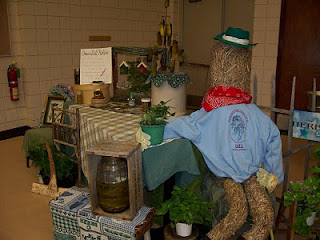
Because if Anne doesn’t tire of it, she will be eating potatoes from the garden next March. This is what I had for dinner last night, banana fingerling potatoes from 2009. Maybe they have seen better days, but they still tasted fine. And they are organic (since I spray nothing—I’m too darn lazy and ornery and cheap) and local (about as local as you can get since my vegetable garden is about 30 feet from my back door).
I guess I was trendy before I knew it. Maybe I will take it a bit further. Do two horses and a plow await my future? Perhaps a cow for milk. Or some chickens to peck at me. I wonder how much the neighbors can put up with on this small city lot I live on.
Garden Day took place at the Horizon Center here in Saginaw, Michigan on Saturday March 27th. This is such a good way to segue into spring. I helped Susan and Gloria work the Saginaw Master Gardener table at the event and managed to sell some of these fine cow pots and hopefully inspire a few gardeners to take the next class being offered in the fall. Actually Gloria was the great sales lady who convinced folks to buy the pots, and Susan kept me on tract to give folks the right change since I was foolishly put in charge of the money.

In the coming months the Master Gardeners will be out and about volunteering in the community, educating and working on beautification projects everywhere we can. It is a wonderful way to show support for the community we live in and care for this good earth. Call it what you want to: the good earth, soil, humus, peat, compost, or my favorite word which is dirt. I ordered some “dirt” which arrived last week and I was just tickled pink to get it. This “dirt” is actually germinating mix, the soilless type that is great for seed starting since it is so porous. I also ordered transplant mix and have some special potting mix I bought at Abele’s last year that I will use for the Cannas I wintered over.
The next few weeks I will share my kitchen, my bedroom , my desk etc. with pots and seed starting trays that I can hopefully be devious enough to keep the cat away from. I do have a gro-light system for seed starting that a friend’s husband made for me, but it never seems to hold everything I want to start. I bought the cat some wheat seeds which I will start in hopes that she will attack it and leave everything else alone.

Okay, here is the beast and she says hi in the only way she knows how-- by hiding every time another human voice passes my threshold. Some folks don’t believe she exists, but I know she does since the food disappears and the litter box fills up.










